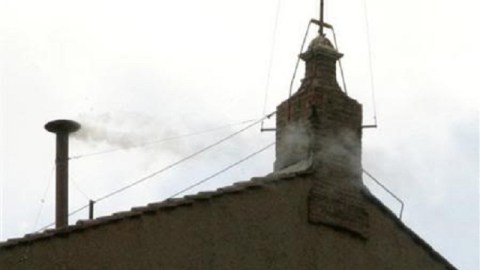What the Papal Conclave Should Really Be Looking At Right Now

As the eyes of the Catholic world (and beyond) remain glued to the chimney of the Sistine Chapel (shown above) for the white smoke indicating the election of a new pontiff, there’s a different picture that the Papal Conclave of Cardinals should be taking note of in the Eternal City. Antonio Garullo and Mario Ottocento’s sculpture The Unspeakable Act speaks about the issues facing the church that the church itself refuses to face. Unfortunately, the duo unveiled their work only after the Conclave closed the doors to deliberate in secret. Maybe, just maybe, the Cardinals should make an exception and come out to take a look at this new piece of art that begs the ancient institution of the Catholic Church to wake up and smell the modernity.
The Unspeakable Act (or in the original Italian, L’inconfessabile gesto, literally “the gesture that cannot be confessed”) features a life-size sculpture of Pope Benedict XVI kneeling in a confessional box, presumably asking forgiveness for his sins. Benedict covers his face with obscenely bejeweled hands as the crimson and cream robes of his office sprawl around him and his tiara rests carelessly on the ground. On the former Pope’s knee rests a Bible open to Luke 18:16, where Jesus says, “Let the little children come to me.” A piece of paper peeks out of the fallen tiara alluding to the Vatileaks scandal. Books by liberal Catholic thinkers Hans Küng and the deceased Cardinal Carlo Maria Martini silently challenge the stricken pope to repent and reform. All these visuals come with a soundtrack of Pope Benedict XVI’s resignation announcement in Latin playing counterpoint to the murmur of nameless voices confessing their own sins.
Garullo and Ottocento specialize in sculpture speaking truth to power, specifically power in their native Italy. Their 2012 piece The Dream of Italy featured a smirking Prime Minister Silvio Berlusconi with his hand down his pants (alluding to his numerous sex scandals) and sleeping in the same kind of glass casket used for popes such as John XXIII. The duo became the first Italian gay couple to be married when they took their vows in Holland in 2002. For more than a decade since, they’ve pled in vain with their country and church to recognize their bans. The Unspeakable Act primarily strikes at the tragedy of the Catholic church’s sex scandals and child abuse cases, but secondarily serves as an all-purpose protest for many of the church’s ills: its homophobia, its questionable financial dealings, and, through its chosen venue, its relationship with women.
The Unspeakable Act appears in Rome’s Palazzo Santa Chiara in its Cappella del Transito di S. Caterina, the site where Saint Catherine of Siena, the co-patron saint of Italy with Saint Francis of Assisi, died in 1380. Just two years after being questioned for heresy by the Dominican Order essentially for calling for clerical reform, Saint Catherine found herself called to convince Pope Gregory XI to return the Papal seat to Rome from Avignon, France, where it had fallen deeply into corruption. Gregory XI returned to Rome, but died in 1377, setting into motion the events leading to the Western Schism of dueling popes: Pope Urban VI in Rome and Pope Clement VII (the “Anti-Pope”) in Avignon. Saint Catherine struggled to restore her shattered church to the end of her short, 33-year life, earning the title Doctor of the Church for her efforts. Of all the women saints, Saint Catherine may embody the most potent combination of faith and intellect, putting all of both unapologetically into her challenge to make the church better serve the faithful, despite the fact that said church would never allow her to become one of its priests, cardinals, or even pope.
The massive mea culpa portrayed in The Unspeakable Act is, of course, pure wish fulfillment on the part of Garullo and Ottocento. Pope Benedict XVI’s resignation, at least in my opinion, seems more of a search for a soft landing amidst scandals ready to crash than any kind of an anguished admission of guilt. There’s as much a chance of the ex-Pope tearfully confessing as there is of the Conclave taking a road trip to see this artwork. Those cardinals realize that the face behind those sculpted hands is their own as much as that of the man they’re finding a replacement for. If they could only open their eyes and see this work as well as the meaning of the place it appears in, perhaps the Cardinals could look to the church’s past—near and distant—and conceive a vision for its future.
[Image: White smoke indicating the election of a new pope. Image source.]





